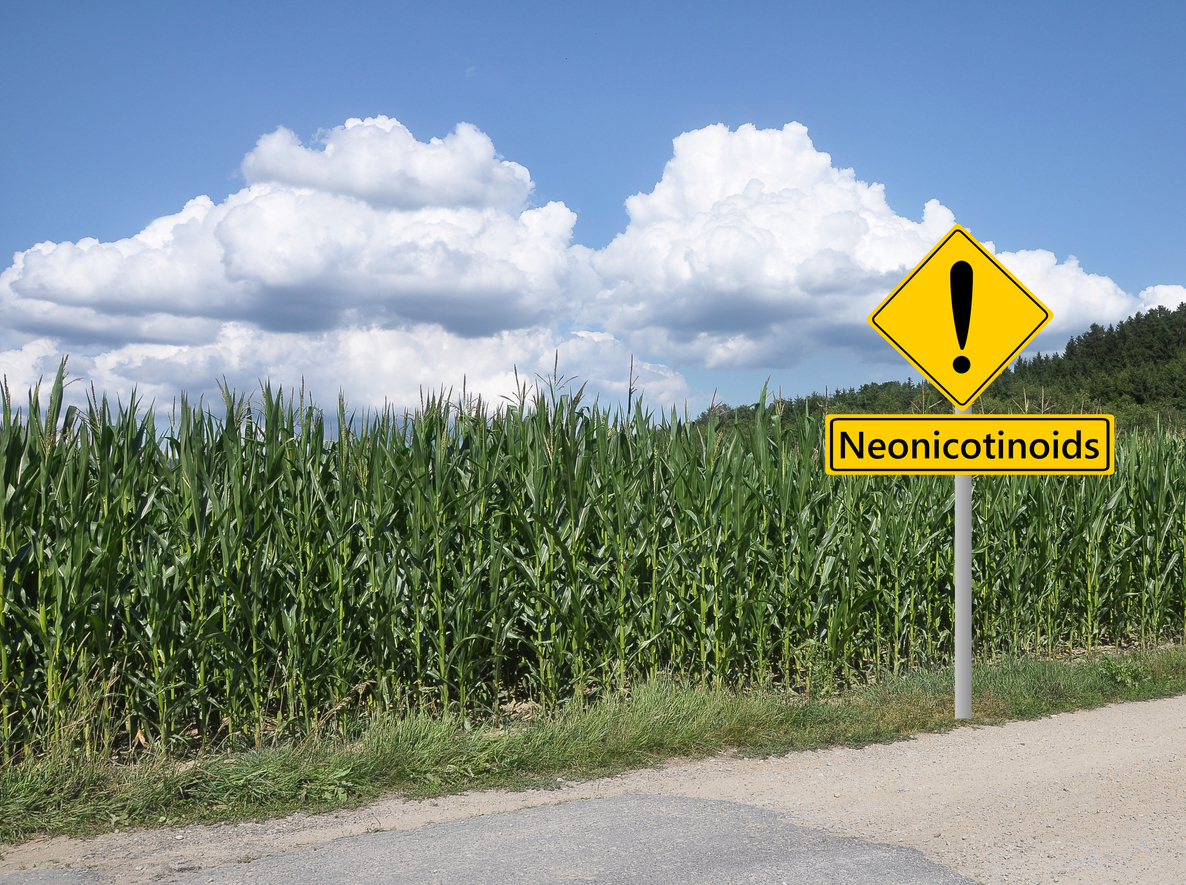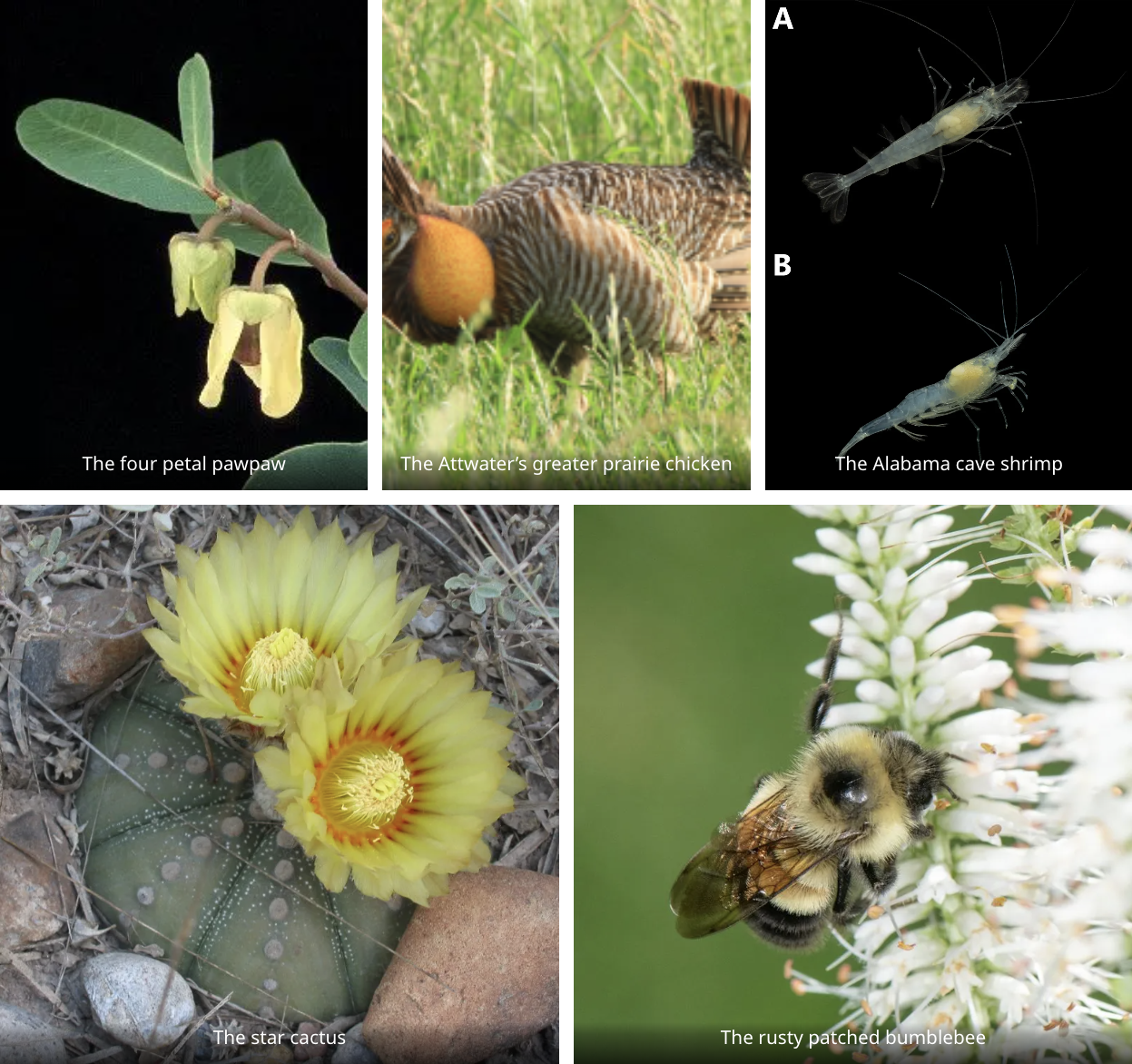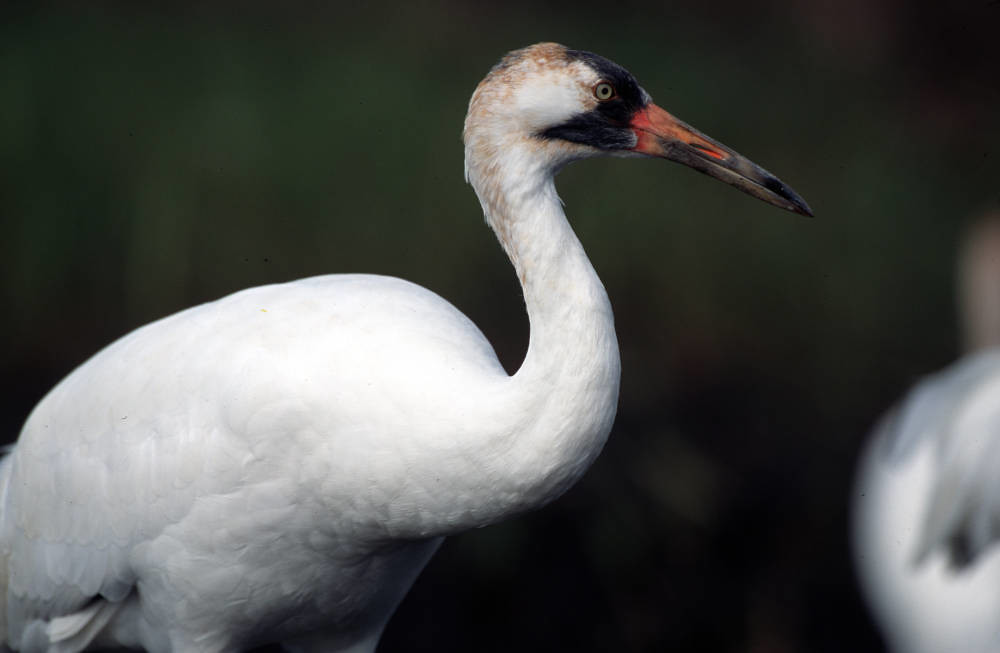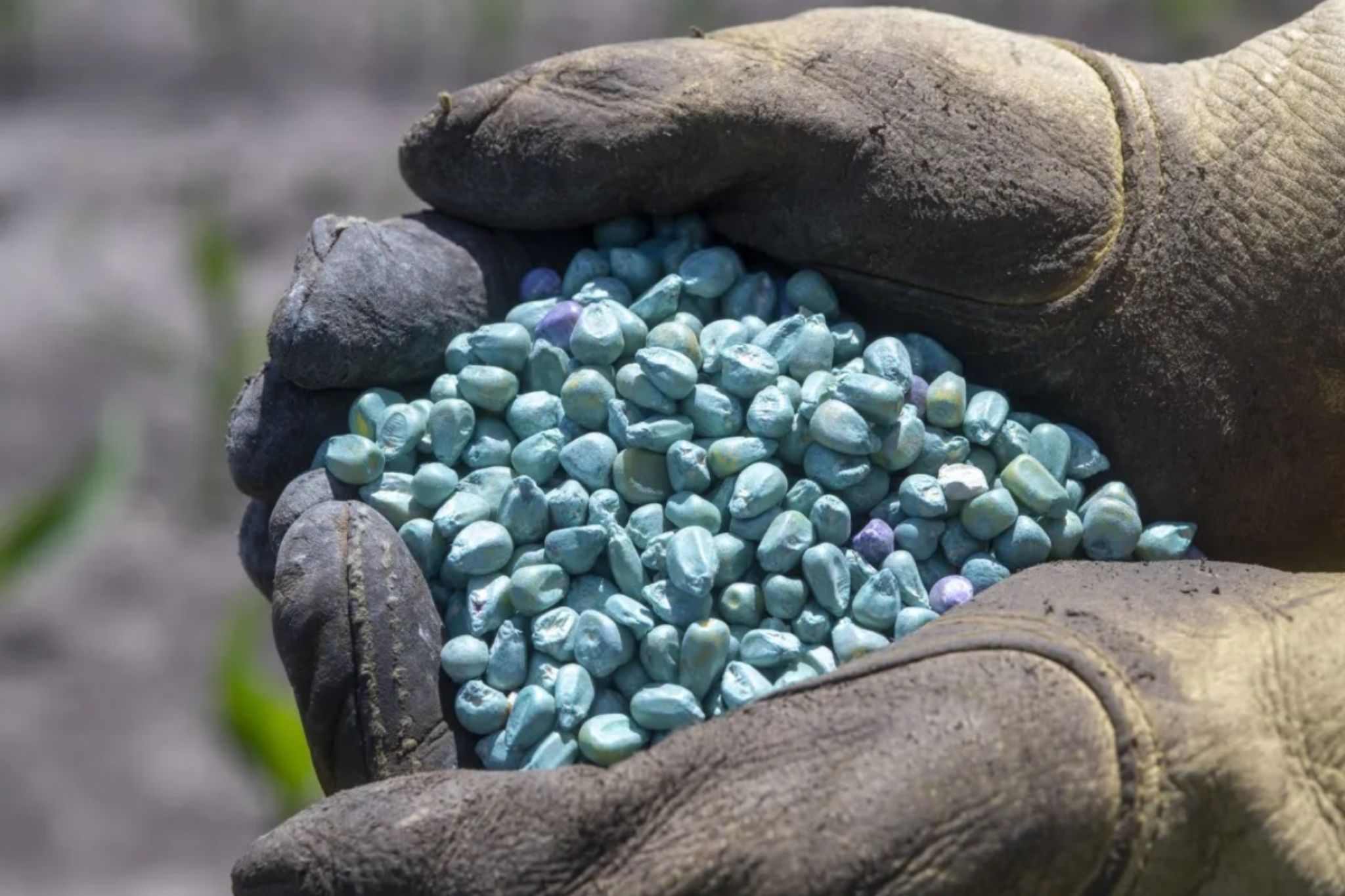by Johnathan Hettinger, Originally published July 20, 2023 on Investigate Midwest
If Clay Bolt went looking for a rusty patched bumblebee, he would head to a city. The wildlife photographer said his best bet would be Minneapolis or Madison, Wisconsin, in a botanical garden or even someone’s backyard — as long as it was far away from crop fields and neonicotinoid pesticides.
“It’s kind of ironic. Cities have become a refuge for some of these most endangered pollinators,” said Bolt, Manager of Pollinator Conservation for the World Wildlife Fund. “Thousands of acres of monocultural row crops leave little to no room for most pollinators.”
The rusty patched bumblebee has seen populations plummet with the rise of industrial agriculture and was given Endangered Species Act protections in 2017. The species, once broadly distributed throughout the eastern United States, is now largely found in small populations in parts of the Midwest.
Today, the rusty patched bumblebee is among more than 200 endangered species whose existence is threatened by the nation’s most widely used insecticides (one classification of pesticides), according to a recent analysis by the US Environmental Protection Agency (EPA). The endangered species range from Attwater’s greater prairie chicken to the Alabama cave shrimp, from the American burying beetle to the slackwater darter. And the star cactus and four-petal pawpaw are among the 160-plus at-risk plants.
Examining Thiamethoxam, Clothianidin, and Imidacloprid

These are likely the most ecologically destructive pesticides we’ve seen since DDT.
The three neonicotinoids — thiamethoxam, clothianidin, and imidacloprid — are applied as seed coatings on some 150 million acres of crops each year, including corn, soybeans, and other major crops. Neonicotinoids are a group of neurotoxic insecticides similar to nicotine and are used widely on farms and in urban landscapes. They are absorbed by plants and can be present in pollen and nectar, and have been blamed for killing bees or changing their behaviors.
Pesticide manufacturers say that studies support the safe use of these chemicals, which in addition to seed coatings, are also sprayed on more than four million acres of crops across the United States, including cotton, soybeans, grains, fruits, vegetables, and nuts. But conservation groups say that the EPA’s analysis has “gaping holes” and downplays the harm to endangered species.
“These are likely the most ecologically destructive pesticides we’ve seen since DDT,” said Dan Raichel, acting director of the Pollinator Initiative at the Natural Resources Defense Council (NRDC), an environmental advocacy group that works to “safeguard the earth — its people, its plants and animals, and the natural systems on which all life depends.”
The chemicals “jeopardize the continued existence of” more than 1 in 10 endangered fish, insects, crustaceans, plants, and birds across the United States, according to the analysis by the Environmental Fate and Effects Division in the EPA’s Office of Pesticide Programs.
Pesticides Drive Species to Extinction
In 1972, the EPA banned DDT, an ecologically destructive insecticide that had gained widespread attention because of Rachel Carson’s book Silent Spring, which chronicled DDT’s role in harming the environment and driving species like the bald eagle toward extinction.
The EPA — which originally approved the three neonicotinoids in 1991, 1999, and 2003 — has been forced by a 2017 court settlement to assess the impact of the chemicals on endangered species.
The EPA has released the analysis with the hope of soon putting into place mitigations of the harm being caused, said Jan Matuszko, director of the Environmental Fate and Effects Division in the EPA’s Office of Pesticide Programs, in an interview with Investigate Midwest. An EPA spokeswoman said the EPA is planning to announce a registration review interim decision sometime in 2024.
However, experts claim the way the agency analyzed the neonicotinoids’ predominant use — as seed coatings on crop seeds before they are planted — underestimates the amount the pesticides move off where they are applied and into species’ habitat.
HERE ARE EXAMPLES OF THE SPECIES AT RISK BECAUSE OF NEONICS:

Neonics Are Harmful to Humans, Too
Use of neonicotinoids skyrocketed in the late 2000s and has continued to rise, despite concerns about effects on pollinators and human health. In 2018, the European Union banned neonicotinoids because of concerns about harm to pollinators. On June 9, the New York state legislature passed a first-in-the-nation bill that would ban neonic-treated corn, soybean, and wheat seeds. [Editor’s Note: The bill was signed into law on 12/22/2023].
In addition to environmental harm, scientists have expressed concerns about neonicotinoids’ effects on human health. In 2020, NRDC filed a petition asking the EPA to ban the use of the chemicals on food because of risks to human health, including neurotoxicity and neurodevelopmental issues for children.
A 2022 study from researchers at 16 institutions across the United States found the chemicals in the urine of 95% of pregnant women in California, Georgia, Illinois, New Hampshire, and New York. A 2023 study by the US Geological Survey found neonics in more than half of wells in eastern Iowa, as well as in the urine of 100% of farmers it tested.
“It’s way worse than what we’re able to pay attention to,” Bolt said.
Agrochemical Companies Continue to Minimize Actual Risks
The chemicals are manufactured by some of the largest agribusiness companies in the world. German chemical company BASF is the lead registrant on clothianidin; German multinational corporation Bayer is the lead registrant on imidacloprid; and Swiss company Syngenta, owned by ChemChina, is the lead registrant on thiamethoxam.
Bayer spokeswoman Susan Luke said Bayer is committed to working with the EPA to “help ensure any new measures proposed by EPA are fully informed and based on sound science.”
“Bayer remains committed to the safe use of imidacloprid under label instructions; safe use that, along with other neonicotinoids, has been reconfirmed by regulators after diligent review worldwide,” Luke said in an emailed statement to Investigate Midwest.
Syngenta spokeswoman Kathy Eichlin said in an emailed statement that more than 1,600 studies have been conducted that support the safe use of thiamethoxam.
“Without neonics, growers would be forced to rely on a few older classes of chemistry that are less effective at targeting pests and require more frequent applications,” Eichlin said.
BASF spokesman Chip Shilling said in an emailed statement that clothianidin presents “minimal risk to humans and the environment, including pollinators.” He said these products “undergo many years of extensive and stringent testing to ensure that there are minimal adverse effects to the environment, including threatened and endangered species, when used according to label directions.”
“We will continue to engage in extensive training and other stewardship activities to ensure that clothianidin seed treatment products are handled and applied safely,” Shilling said.
EPA and the Endangered Species Act

“This is, as far as we know, unprecedented. I’ve never seen a determination that was this large in scope,” NRDC’s Raichel said of the EPA’s analysis, adding, “EPA violated the Endangered Species Act when it approved these pesticides.”
Though the EPA was founded at the height of the environmental movement ignited by Silent Spring, the EPA has never assessed the impact of pesticides, which includes herbicides, insecticides, fungicides, and rodenticides, on endangered species since the Endangered Species Act was signed into law by former President Richard Nixon in 1973.
However, the EPA has consistently lost Endangered Species Act lawsuits for decades. In April 2022, the Biden administration pledged to take action and released an Endangered Species Workplan for pesticides.
Under the Endangered Species Act, the federal government cannot take any action that will “jeopardize the continued existence” of a protected species. In other words, the federal government cannot drive a species toward extinction.
If the government’s action is found to do so, it is called a “jeopardy” finding — which is rare. A 2015 review of seven years of consultations found only two jeopardy calls of more than 88,000 actions taken by the federal government during that time period. Jake Li, a coauthor of that review prior to joining the EPA, is now Deputy Assistant Administrator for Pesticide Programs at the EPA, overseeing the pesticide office.
Any federal agency that believes an action may harm an endangered species must consult with the US Fish and Wildlife Service or National Marine Fisheries Service (depending on the species at risk) to see if that harm rises to the level of jeopardy — which means the species is less likely to survive because of the action.
Neonicotinoids EPA Evaluations
In the case of these three neonicotinoids, the EPA released a biological evaluation in 2022, finding that these specific insecticides are likely to adversely affect — or harm — between 1,225 and 1,445 listed species, depending on the active ingredient. This is between two-thirds and three-fourths of all protected species in the US.
The US Fish and Wildlife Service or National Marine Fisheries Service is then supposed to weigh whether that harm would rise to the level of extinction. In this instance, however, the EPA did its own analysis because the two agencies are backlogged in their analyses on pesticides, Matuszko said.
“It’s going to be a while before it (the services’ analysis) comes out,” Matuszko said. “The reason we’re doing this is to get mitigations in place for listed species much earlier. We want to be able to protect those species before we go through the entire consultation process.”
A spokeswoman for the US Fish and Wildlife Service — which oversees the implementation of the ESA for terrestrial species and freshwater species — declined to answer questions, instead referring questions to the EPA.
Genevieve O’Sullivan, a spokeswoman for CropLife America, said the trade organization that represents pesticide manufacturers appreciates EPA’s work on the analysis to get mitigations in place for protected species.
“The new report provides better data for industry and growers to work with the relevant federal agencies as they determine additional mitigations for the continued responsible use of pesticides,” O’Sullivan said in an emailed statement.
EPA Analysis: Largest Use of Neonics Doesn’t Impact Endangered Species

The EPA’s analysis, though, found that the largest use of neonicotinoid insecticides — as seed coatings — will not cause species to go extinct. Researchers who study the environmental impacts of neonicotinoids say the EPA’s analysis downplays the risks.
Justin Housenger, a branch chief in the Environmental Fate and Effects Division of the EPA’s Office of Pesticide Programs, said in an interview that in the EPA’s analysis, they found seed treatments to be safer than other uses of the chemicals because seed treatments have “no off-site transport,” meaning they don’t run off into water or drift into the air.
However, it is “widely accepted” by researchers that seed treatments do move off of where they are applied, said Christian Krupke, a professor of entomology at Purdue University, who has published extensively about the environmental impacts of neonicotinoid seed treatments.
Research by Krupke and others shows that treated seeds lose up to 95% of the pesticide to the environment. This happens through seed abrasion and drift during the planting process or loss to soil or waterways through erosion. Birds can also eat treated seeds that are not properly buried.
“There is no doubt that there are important nontarget effects (of seed treatments),” Krupke said.
Housenger said because the seeds are precision planted in fields, they likely don’t move off of where they are planted. He also said that the EPA’s analysis recognized that “dust off” of pesticides during planting could happen, but doesn’t “quantitatively assess it further.”
Housenger added that seeds are physically too big for many endangered birds to eat. Further, the EPA’s analysis found that unless a species’ habitat was the treated agricultural field and its diet was primarily seeds, it would not face a jeopardy call, Housenger said.
“Unlike with foliar and soil applications, there’s no off-site transport,” Housenger said. “When you stack all these lines of evidence together, that’s why you’ve got this relatively low number, even though seed treatment considerations and uses were considered.”
The EPA Has Ignored Scientific Research on Seed Treatments
The EPA’s assessment disregards well-established research in the field, said Maggie Douglas, Assistant Professor of Environmental Science at Dickinson College.
“I don’t know where that disconnect is coming from, but it does seem to exist,” Douglas said. “At this point, there’s quite a lot of evidence that this (movement) is happening. Seed treatments are not just staying in the field.”
In recent years, the US Geological Survey has found neonics in rivers across the United States, tributaries to the Great Lakes, and well water and groundwater in Iowa.
“Treated seeds are no question in my mind why we’re finding this,” said Dana Kolpin, a research hydrologist with the US Geological Survey, who has been an author on many of those studies.
A 2021 study by Kolpin and others found that clothianidin was in 68% of groundwater in northern Iowa and southern Minnesota. Clothianidin is used heavily as a seed treatment in corn but is rarely used otherwise in those states.
That these chemicals are used on half of all cultivated cropland shows how widespread the pollution could be, said Bill Freese, science director at the nonprofit Center for Food Safety.
“It’s a huge issue. We’re talking the biggest crops in America,” Freese said. “Yet EPA is convinced these seed treatments don’t jeopardize species. I think that’s the most glaring evidence of how bad their assessments are.”
Lack of Knowledge About Neonic Usage

No one knows the exact acreage planted with neonicotinoid-treated seeds, but it is by far the largest-scale use of the chemicals, said Douglas, who has published extensively on tracking how, where, and to what extent neonics are used.
As of 2012, about 150 million acres of crops were planted with neonicotinoid-treated seeds each year; the coatings are applied to the seed prior to planting. Neonicotinoids are considered systemic, which means that plants absorb the chemicals and spread them through their circulatory system. This makes flowers, leaves, nectar, and pollen harmful to both pests and nontarget insects.
The neonicotinoids can often be taken up by nontarget plants, including wildflowers and other native plants on the edges of fields. A paper by Krupke found that more than 42% of the land in Indiana is exposed to neonic pesticides during corn planting, impacting the habitat of more than 94% of the bees in the state.
The US Geological Survey, which tracks overall pesticide use by purchasing data from a third-party contractor that gathers the information via farmer surveys, stopped tracking seed treatments in 2015 because the data was too complex and full of uncertainties, according to the USGS website. [Editor’s Note: However, the USGS recently announced they will be tracking pesticide-use estimates again and will publish data from 2018-2022 in 2025.] Many farmers also do not know which seed coatings they are planting, making accurate information difficult to get, Douglas said.
After the USGS stopped tracking seed treatments, recorded use of the chemicals — through applications by growers, such as spraying — fell significantly. Imidacloprid usage immediately dropped in half, while thiamethoxam use has dropped about seven-fold, and clothianidin usage has dropped more than 35-fold, USGS data shows.
Housenger said the EPA also does not know exactly how many acres currently are treated with neonic-coated seeds. An EPA spokeswoman, though, said the agency estimates that between 70% and 80% of all corn, soybean, and cotton acres are planted with neonicotinoid-treated seeds. In 2023, that would range from 135.3 million to 154.64 million acres. This does not include treated seeds of other crops, including fruits and vegetables.
Coated Seeds Unregulated
The Endangered Species Act is the sole way to mitigate environmental harm from treated seeds, because of a loophole in how these seeds are regulated.
The EPA regulates all pesticides through the Federal Insecticide, Fungicide, and Rodenticide Act, or FIFRA. Using that standard, the EPA must weigh whether a pesticide causes “unreasonable adverse effects on the environment.” But unlike the Endangered Species Act, the EPA has the discretion under FIFRA to make a determination of whether environmental harms outweigh the benefits caused by the use of pesticides.
Seed coatings, however, aren’t regulated by FIFRA.
The EPA exempts seed coatings because of a loophole called the treated article exemption. Originally designed so the EPA didn’t have to evaluate the safety of lumber treated with chemicals for preservation, the EPA has since expanded that definition.
On May 31, 2023, the Center for Food Safety, a nonprofit that promotes environmentally safe and healthy food systems, filed a lawsuit against the EPA, arguing that the agency cannot exempt coated seeds under FIFRA because they, unlike other “treated articles,” have widespread devastating impacts that EPA does not properly assess.
Krupke said there is little research that supports the effectiveness of seed coating to protect corn and soybeans under typical field growing conditions. A 2014 analysis by the EPA found that soybean neonicotinoid coatings “provide negligible overall benefits to soybean production in most situations.”
“We don’t need to be using nearly as much of these as we’re using,” Krupke said. “This is an avoidable problem. In most cases, it’s not helping crops, yields, or farmers.”
Citations & References:
-
[1]
-
[2]
-
[3]
-
[4]
-
[5]
-
[6]
-
[7]
-
[8]Interview with Jan Matuszko, EPA, May 23, 2023.
-
[9]Interview with Dan Raichel, NRDC, May 25, 2023.
-
[10]Interview with Aimée Code, Xerces Society, May 17, 2023.
-
[11]
-
[12]Email correspondence with Dan Raichel, NRDC, June 12, 2023.
-
[13]
-
[14]
-
[15]
-
[16]Email correspondence with Susan Luke, Bayer, May 26, 2023.
-
[17]Email correspondence with Kathy Eichlin, Syngenta, May 25, 2023.
-
[18]Email correspondence with Chip Shilling, BASF, June 14, 2023.
-
[19]
-
[20]Interview with Amy van Saun, Center for Food Safety, May 18, June 15, 2023.
-
[21]Interview with Lori Ann Burd, Center for Biological Diversity, May 17, 2023.
-
[22]
-
[23]Email correspondence with Vanessa Kauffman, U.S. Fish and Wildlife Service, May 24, 2023.
-
[24]Email correspondence with Genevieve O’Sullivan, CropLife America, June 20, 2023.
-
[25]Interview with Justin Housenger, EPA, May 23, 2023.
-
[26]Interview with Christian Krupke, Purdue University, May 18, 2023.
-
[27]Interview with Maggie Douglas, Dickinson College, June 13, 2023.
-
[28]Interview with Dana Kolpin, U.S. Geological Survey, May 22, 2023.
-
[29]
-
[30]Interview with Bill Freese, Center for Food Safety May 12, 2023.
-
[31]
-
[32]
-
[33]Email correspondence with Cathy Milbourn, EPA, June 20, 2023.
-
[34]
-
[35]
-
[36]Interview with Tierra Curry, Center for Biological Diversity, June 12, 2023.
—–
Investigate Midwest is an independent, nonprofit newsroom. Their mission is to serve the public interest by exposing dangerous and costly practices of influential agricultural corporations and institutions through in-depth and data-driven investigative journalism. Visit them online at www.investigatemidwest.org
Tell us in the comments:
- Have you heard of neonicotinoids before?
- Do you think the EPA should do more to regulate pesticides and protect endangered species?
- How do you deal with pests when growing food?
Featured Image: iStock.com/Anton Skripachev

